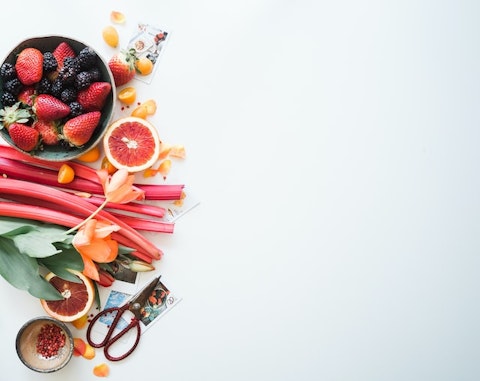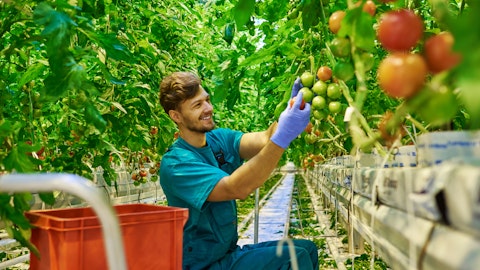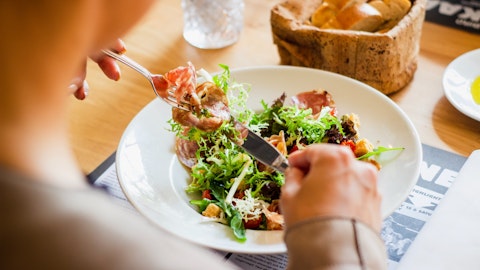SunOpta Inc. (NASDAQ:STKL) Q4 2022 Earnings Call Transcript March 1, 2023
Operator: Greetings, ladies and gentlemen, and welcome to SunOpta’s Fourth Quarter 2022 Earnings Conference Call. All participants are currently in a listen-only mode; however, a question-and-answer session will follow the prepared remarks. And as a reminder, this conference is being recorded. I would now like to turn the call over to your host, Mr. Reed Anderson with ICR. Please go ahead, sir.
Reed Anderson: Good afternoon, and thank you for joining us on SunOpta’s fourth quarter fiscal 2022 earnings conference call. On the call today are Joe Ennen, Chief Executive Officer; and Scott Huckins, Chief Financial Officer. By now, everyone should have access to the earnings press release that was issued earlier this afternoon and is available on the Investor Relations page on SunOpta’s website. This call is being webcast, and its transcription will also be available on the company’s website. As a reminder, please note that the prepared remarks which will follow contain forward-looking statements, and management may make additional forward-looking statements in response to your questions. These statements do not guarantee future performance, and therefore, undue reliance should not be placed upon them.
We refer you to all risk factors contained in SunOpta’s press release issued this afternoon, the company’s annual report filed on Form 10-K, and other filings with the Securities and Exchange Commission for a more detailed discussion of the factors that could cause actual results to differ materially from those projections in any forward-looking statements. The company undertakes no obligation to publicly correct or update the forward-looking statements made during the presentation to reflect future events or circumstances, except as may be required under applicable securities laws. Finally, we would like to remind listeners that the company may refer to certain non-GAAP financial measures during this teleconference. The reconciliation of these non-GAAP financial measures was included with the company’s press release issued earlier today.
Also, please note that unless otherwise stated, all figures discussed today are in US dollars and are occasionally rounded to the nearest million. I’d like to now turn the call over to Joe.
Joe Ennen: Good afternoon, and thank you for joining us today. We had another very strong performance in the fourth quarter with revenues in line with guidance, while profitability was significantly above, reflecting solid execution against our key priority of driving strong profitable growth in plant-based and fruit snacks and continuing the optimization of frozen fruit profitability. Please note my prepared remarks will generally exclude the impact of our sunflower business, which was divested at the beginning of the fourth quarter. Let me offer some key takeaways before we begin unpacking the results. Q4 success was achieved much the same way we have driven the business all year, strong broad-based revenue growth in plant-based from both pricing and real volume growth, fruit snacks continues to experience incredible growth and frozen fruit saw continued improvement in profitability linked to better execution.
Q4 adjusted EBITDA of $23.5 million was up 123% and was the highest quarter in company history on a normalized basis as we continue to efficiently scale our business and optimize performance across our entire portfolio. In plant-based, revenue growth remains incredibly broad-based. Oat, almond, soy, and coconut all grew double digits, with double-digit increases in retail and over 30% growth in foodservice. We also saw double-digit growth in each of our top three customers. Additionally, all the ways in which we go-to-market were up double digits, led by our own branded portfolio, which was up 40%. This broad growth is a testament to our competitive advantages and shows we have numerous ways to win with the business model we have built. Our plant-based growth was supported by solid gains in volume in addition to pricing.
Customer demand in the quarter was very strong, very steady and very consistent and, as I mentioned, very broad-based. We continue to see profit improvements in the fruit segment resulting from the strategies we have talked about extensively. Mix shift to value-added products and network optimization, along with better execution, are delivering results with fruit segment gross profit up 95%. We continue to recover almost all inflationary costs with customer pricing adjustments. We continue to deliver outstanding customer service with case fill rates in plant-based over 98% and fruit-based over 97%. We continue to make gains in business development as our value proposition and competitive advantages continue to attract new customers as well as growing with existing customers.
We continue to execute on our capital expansion plans with our 285,000 square foot greenfield plant in Texas now in operation. We went from first bulldozer to first production in less than 16 months. Lastly, solid execution in 2022 has created durable momentum for the business and we are well positioned for another strong year in 2023. Now, I’ll turn to our segment results, starting with plant-based, where we remain focused on three strategic priorities. Number one, strengthening and fortifying our competitive advantages; number two, winning an oatmeal; and number three, building a balanced multipronged go-to-market business that includes co-manufacturing, private label, and owned brands. Plant-based revenues were up 23% in the fourth quarter to $136 million, with growth split approximately 60/40 between pricing and volume with both factors up double digits.
These results once again underscore the competitive strength of our platform and why we are frequently a partner of choice. We employ our customers across the full spectrum of channels and categories with industry-leading capabilities and innovation, providing multiple pathways for driving profitable, sustainable growth. Within the segment, core plant-based milk revenue increased 22% and accounted for over 60% of the total segment revenue. Our tea business also continued to deliver outstanding results with the growth rate accelerating further to 57%, driven by strong customer demand. Finally, broth sales grew 10%, a solid recovery from the third quarter, in part driven by promotional efforts at select customers. Focusing on plant-based milks, we continue to see broad strength across the portfolio as four of our five product types experienced double-digit growth rates.
Oat continues to be a strong driver of our plant-based growth and revenue from all oat products was up 37%. Coconut milk was up 30%, reflecting gains in food service; and soy milk was up mid-teens, with almond milk up low double digits. Next, I’ll provide some context on the plant-based milk category and its recent performance based on retail scan data. As a reminder, we would estimate retail scan data only captures roughly one-third of total shelf-stable plant-based milks with untracked food service and club representing two-thirds of the volume. We continue to see solid growth in the overall plant-based milk category. In the 13 weeks that coincide with our fourth quarter, total plant-based milk dollars grew 12%, while units declined 4%. Category growth continues to be led by oat milk with dollars growing 23% and units growing 4%.
Looking beyond scan channels, our business results would suggest very strong growth in food service and better than retail growth in Plug. Looking at SunOpta’s results by customer channel, total retail was up 17%, reflecting strong growth in mas and club, along with further growth from a large command customer. Foodservice, which includes our biggest customer, had a very strong performance. The channel sales increased 32%, reflecting significant gains in our Dream branded oat milk. Dream Oat Milk and food service helped propel our overall branded business, up 40% in the fourth quarter, making brands our top-performing go-to-market approach. In addition, we continue to see some resurgence in soy milk led by younger consumers. Our West Life brand of non-GMO soy products was the fastest-growing brand in the shelf-stable category in the last 13 weeks, fueled by product innovation, distribution gains, and consumer interest in the superior protein content and nutrition profile of soy milk.
While not a huge base, it shows our ability to work the edges of the category with innovation. Private label was also very strong, up 35%, driven by broth and new distribution. Co-man revenue rose 14%, reflecting pricing and broad-based gains across major customers and channels. As it relates to capacity expansion projects, all six of our projects needed to double capacity are now complete. These projects have been instrumental in fueling our growth. Plant-based segment revenue and gross profit has doubled since 2018, including 40% growth in the last 24 months. Our greenfield plant in Midlothian, Texas was completed on time and on budget, which is an amazing feat given the macro volatility experienced over the past 16 months around the availability of everything from steel, to equipment, to labor.

Photo by Brooke Lark on Unsplash
We’ve hired over 100 employees, and many of them have been cross-training at our other plants for a month. We are currently manufacturing salable product and expect volumes to ramp steadily over the next six months. Maybe even more exciting is that commissioning is nearing completion on our 330-milliliter protein shake line, and we expect to begin initial production in Q2 as planned. Over the past several months, we posted visits with many of our top current and prospective customers and their reactions have been overwhelmingly positive. Overall, business development continues to go quite well. as we will be onboarding several new customers in 2023 and just as importantly, expanding business with existing customers. These wins were enabled by Texas, both from a capacity standpoint as well as its attractive geographic location for both SunOpta and our customers.
Moving on to our fruit-based segment. Recall our three strategic priorities are; one, de-risking the business through geographic diversification, customer pricing programs and better grower relations; two, becoming the low-cost operator in frozen fruit through automation, footprint reengineering and aggressive cost takeouts; and three, evolving the portfolio via mix shift and innovation towards more value-added offerings. Fourth quarter results in fruit fully reflect execution of these three strategies. We saw surge in growth in fruit snacks, partially offset by expected moderation in frozen fruit as we continue to shift the mix. Segment revenues were up over 4%, driven by a 56% increase in fruit snacks. Impressively, nearly 80% of this growth came from volume reflecting a continuation of the strong consumer demand trends we’ve seen all year.
This core growth is combined with our ability to leverage key innovations and increased capacity across major retail and CPG customers points to a continued bright future for Snacks. Importantly, we delivered significant margin expansion across the entire food-based portfolio as we captured scale-related efficiencies in fruit snacks and benefited from our reduced manufacturing cost base and portfolio rationalization in frozen fruit. Gross profit dollars in our fruit-based segment nearly doubled in the fourth quarter and margin improvement followed a similar trajectory. Turning to our ESG initiatives, we made significant progress in the year. We continue to make real progress towards zero waste in our plans. We joined SEDEX to enhance transparency in our supply chain, and we have made significant progress towards sustainable packaging solutions.
As we outlined at Investor Day, one of our goals is to be and be recognized as a sustainability food and beverage company. In 2022, we improved our CDP score to a B- above the food and beverage industry average of a C. For those not familiar, CDP is a non-profit company, which runs a disclosure system for investors, companies, and governments to manage their environmental impacts. Additionally, our most recent sustainability report clearly outlines our multiyear goals and plans for operating the business consistent with our sustainability heritage. In summary, 2022 was a very good year for SunOpta as we significantly expanded capacity, continue to reshape our portfolio, and again delivered significant growth in revenues and profitability. We entered 2023 in a very strong competitive position with numerous tailwinds that will propel our business, further leverage our strong platform to capture additional share, and expand our addressable market.
Our outlook for 2023 is largely unchanged from what we first shared with you several quarters ago at our Investor Day in June of 2022. We remain committed to our long-term growth algorithm of annual double-digit plant-based revenue and profit increases and increasing returns on invested capital. Now, I’ll turn the call over to Scott to take us through the rest of the financials. Scott?
Scott Huckins: Thank you very much, Joe and good afternoon everyone. Fourth quarter revenues of $221 million were up 8.4% year-over-year as reported and grew 16%, excluding the divested sunflower business. Plant-based revenue increased 23%, excluding sunflower with pricing up 1% and volume up a strong 10%. Fruit-based revenues increased 4.5% led by fruit snacks, which grew 56%. Consolidated gross profit increased 56% to $28 million and was up 82% to $33 million excluding $4.6 million of start-up costs for our Texas plant. Consolidated gross margin was up 400 basis points to 12.8% despite the impact of 210 basis points of start-up costs and approximately 80 basis points of headwind from the dilutive effect of passing through higher input costs to customers.
In plant-based, segment-level gross profit increased 46% to $21 million and was up 78% to $25 million, excluding the impact of start-up costs for Texas. Gross margin in plant-based was up 360 basis points to 15% and would have been 330 basis points higher if we exclude start-up costs for Texas. Of the increase in gross margin, approximately 120 basis points was due to the sunflower divestiture. The increase in gross margin reflected both volume growth and pricing. In fruit-based, segment level gross profit rose 95% to $7 million and gross margin increased 420 basis points to 9%. The improvement in gross margin was driven by lower manufacturing costs and increased pricing in frozen fruit and significant volume growth, price increases and plant efficiencies in our fruit snack operations.
I would like to reiterate that our focus is on increasing EBITDA growth, driven by gross profit expansion. We are pleased to see this flowing through the P&L. Segment operating income was $5.2 million in the fourth quarter compared to a $1.7 million loss last year, mostly reflecting higher gross profit along with a $1.6 million FX gain. Earnings attributable to common shareholders for the fourth quarter was $0.2 million compared to a loss of $6.8 million in the prior year period. Adjusted EBITDA was $23.5 million or 123% higher than $10.6 million in the prior year. As a percentage of revenue, adjusted EBITDA more than doubled from 5.2% last year to 10.6% this year. Turning to the balance sheet and cash flow. To start, we are pleased with where we are on the balance sheet, both from a leverage and debt maturity perspective.
For context, we have invested over $200 million of growth capital over the last two years as we seek to double our plant-based business. our core credit facilities are not due until the end of 2025. As of December 31st, 2022, total debt was $308 million with leverage of 3.7 times at the end of the fourth quarter. As a reminder, our target leverage is two times to four times. We continue to expect to be within that range at year-end 2023 and with the first half of the year towards the higher end of the range, followed by gradual improvement as we continue ramping the production capacity that came online over the last couple of quarters. From a cash flow perspective, we had a strong fourth quarter. with positive cash flow before and after capital investment.
The divestiture of the sunflower business contributed $8 million to the fourth quarter cash flow profile. Cash provided by operating activities during the fourth quarter of 2022 was $27 million compared to $20 million during the fourth quarter of 2021. Cash used in investing activities was $20 million compared with $23 million in last year’s fourth quarter, primarily reflecting investments in capacity expansion projects, partially offset by proceeds from the recent divestiture of the sunflower business. Let me close with comments on our outlook, recognizing the environment remains fluid. I will provide our guidance for 2023, along with some perspective on other items across the financial statements. From a guidance standpoint, we expect revenue in a range of $1 billion to $1.05 billion, representing 14% to 20% growth, excluding the divested sunflower business.
We would expect the majority of that growth to come from volume, with the balance driven by the wraparound of pricing actions taken throughout 2022. As a reminder, 2022 included $58 million of sunflower revenue, including $17 million in Q1 that will not recur in 2023. Please also refer to the commentary on last year’s Q1 call for one-time revenue gains in that quarter. From an adjusted EBITDA standpoint, we would expect a range of $97 million to $103 million, which represents 16% to 23% growth. As we think about the pacing of EBITDA in 2023, we would expect a roughly 45/55 split in the first and second half of the year with the back half benefiting from the ongoing ramp-up of our Texas facility. Let me also cover a few of our other financial statement items as we see them developing in 2023.
From a P&L standpoint, we would expect SG&A to be up low double-digit percent, consistent with the outlook shared at Investor Day, driven in part by stock-based compensation expense. Depreciation will be up $7 million to $8 million as capacity expansions begin depreciated. Interest expense will be up $12 million to $13 million with roughly half due to rising interest rates on credit facilities and half from interest on the capital leases used to finance expansion projects. Finally, we would expect $10 million to $12 million of start-up costs related to our capital expansion projects with the flow being approximately $6 million in Q1, $3 million in Q2 and $1 million each in Q3 and Q4. As a reminder, start-up costs are recorded in cost of goods sold, reducing gross profit and gross margin and are added back to EBITDA.
From a balance sheet and cash flow standpoint, we would expect capital expenditures on the cash flow statement between $35 million and $45 million, assuming no material new growth investments. Free cash flow is expected in a range of $25 million to $35 million with year-end leverage in the mid-3s. Each of these estimates are consistent with what we laid out at our Investor Day in June of 2022. As we think about the business post 2025, we would expect a financial algorithm for the total company of low double-digit revenue growth, high teens gross margins with low teens adjusted EBITDA margins and capital expenditures of mid-single-digits as a percentage of revenue. As a reminder, we have said for a long time that we need to deliver a 14.5% CAGR in our plant-based business to achieve our 2025 targets and beyond.
One final item to mention. We are planning to host an Analyst and Investor Meeting in mid-April at our newly opened Lothian, Texas facility. This event will showcase our new facility, including an overall update on our business, along with the plant tour. We intend this to be both an in-person event and a live webcast will also be available. There will be more details to come. Before opening up the call for questions, just a reminder that for competitive reasons, we do not provide detailed commentary regarding customer or SKU level activity. And with that, operator, please open the call for questions.
See also 25 Best Countries to Start a Business and 17 Most Valuable Furniture Companies.
Q&A Session
Follow Sunopta Inc. (NASDAQ:STKL)
Follow Sunopta Inc. (NASDAQ:STKL)
Operator: Thank you. We’ll take our first question this afternoon from Brian Holland of Cowen.
Brian Holland: Yes. Thank you. Good afternoon. If I could just start with, obviously, really strong performance in the plant-based beverage category. I know that’s been a point of some sensitivity among investors who just kind of look at the high-level data and wondering how that conveys to your business. So, obviously, strong execution here and implies continued share incursion. As we go out to 2023, though, and we — obviously, we see at a high level some deceleration. And Joe, I appreciate the color you provided around how that data — the scanner data impacts and what it doesn’t catch in your business? It would be helpful if we have a little sense of to the extent that you maybe tether your guidance to underlying category forecast if there’s a range of outcomes for the plant-based beverage category in 2023 that you’re using as a starting point there that you could help us frame that?
Joe Ennen: Yes, good morning or good afternoon, Brian. So, you’re asking about our category forecast as it relates to scan — scanner data?
Brian Holland: No, it doesn’t have to — yes, it doesn’t have to be — just at a category level, I mean, do you have an assumption for the plant-based beverage category grows between X and Y in 2023 and then we’re going to take this amount of share. I guess I’m just curious what your starting point is for the category because I think that would help people understand the pace of share incursion that you’re anticipating and the extent to which you are maybe making some reasonable assumptions for how the underlying category is going to grow.
Joe Ennen: Yes. We’ve certainly seen — so I’ll talk about track channels. We have seen tracked channel growth in the kind of mid-teens for going back for several years, Brian, I mean fully if you go back even 10 or 15 years, one of the things that you’ve seen with plant-based milks is just a very consistent low double-digit CAGR. And we don’t see anything that would suggest there is a deceleration around plant-based milks from a revenue growth standpoint. I mean that has been the CAGR for fully over a decade. We’re also seeing really strong growth in foodservice. We continue to see consumers in that channel migrate to plant-based milks. We see when oat milk gets brought in, it is largely incremental, which is a great benefit for the overall category and the momentum.
And then in the non-tracked retail channels, Think Club and other non-track channels I mean, again, strong double-digit growth rate. So, overall, I mean, that’s what we see. Obviously, for the last really, I don’t know, four to six quarters, our performance has significantly exceeded the category growth, and we would expect that to continue.
Brian Holland: Got it. I appreciate the color there, Joe. And maybe switching just for a minute. Obviously, there’s been a lot of weather events up and down the West Coast. I’m just curious if you could give us any update, and I obviously understand the evolution of the fruit business, and it’s more heavily weighted towards Mexico. But whether it’s tree nuts or fruit crops — if you could provide any color on what you’re seeing there and any impact to your business upstream in 2023?
Scott Huckins: Hey Brian, it’s Scott. Thanks for the question. So we’re in the heart of the Mexico season now. We’re seeing good quality availability. We won’t be ramping California production, call it, until May. At least the scan here reports we have so far suggests a perfectly fine season. There’s certainly been some erosion from the severe weather. At the same time, there’s been more acres planted. So, I think we’re at least as we sit here in March, not of a view that we’re going to see anything better or worse than we would expect.





